Reported by PMOI/MEK
Iran, June 12, 2019 – On Tuesday, a group of clients who had invested in the Thamen Financial Institute, affiliated to the regime’s terrorist-designated Revolutionary Guards (IRGC) rallied in front of the mullahs’ public prosecutor’s office in Tehran, protesting and demanding their stolen money be returned.
The protesters were heard chanting, “With one less embezzlement, our problems would be solved,” referring to the deep-rooted corruption that has engulfed the entire regime from top to bottom.
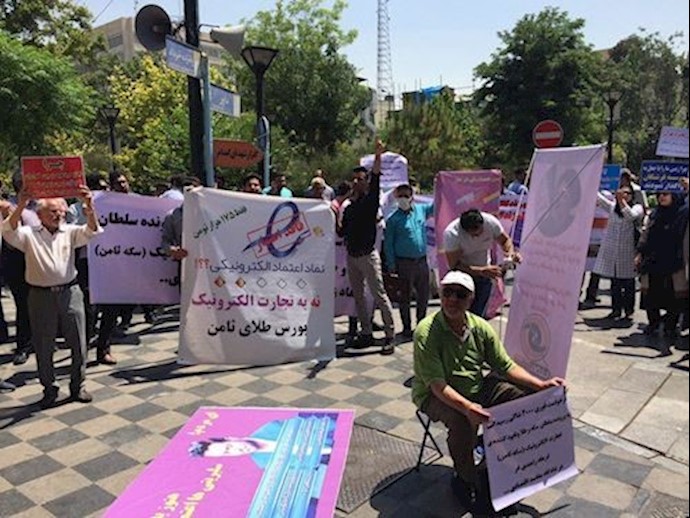
Protesters demand looted money from Thamen Institute – Tehran, Iran – June 11, 2019
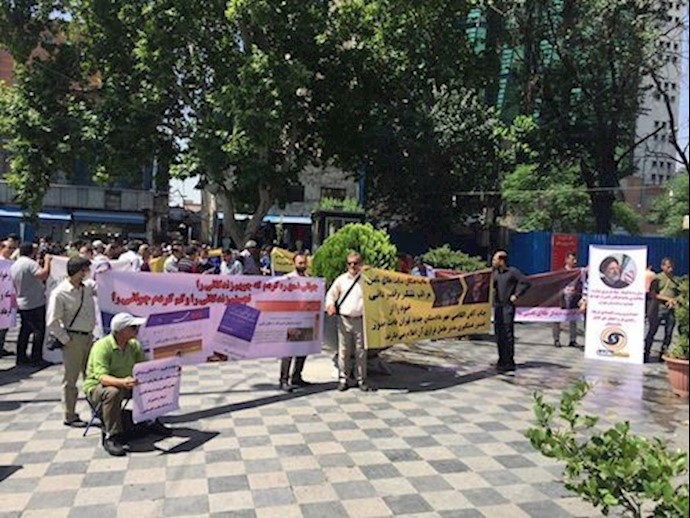
Protesters rallying outside a regime courthouse demanding justice and their looted money back from an IRGC-affiliated financial institution – Tehran, Iran – June 11, 2019
Read More:
Described as “deposit losers,” thousands of people who had invested in state-run credit firms are demanding their money and receiving no answers in return.
The term “deposit losers” in Iran is a new socioeconomic expression. This term is said to be a part of the Iranian people whose financial deposits have been deposited by governmental financial institutions or other approved organizations for buying a home or a vehicle, etc. but have not been returned to them and even illegally blocked. Hence, these people are called the Deposit losers. But the concept recently used by these people themselves is “looted”, which is a more precise expression of this phrase. These financial and credit institutions are affiliated with the Revolutionary Guards and other military and civilian organizations of the Iranian regime.
Currently the “looted” movement in Iran has become a mass movement in cities such as Tehran, Rasht, Mashhad, and others that are taking place in the form of protests, sit-ins and marches against the economic corruption in Iran’s banking system or government institutions and banks.
This movement, which was initially just a guild movement, began to develop itself as a political movement right after the expansion of protests and the lack of accountability of Iranian regime officials to the people whose property was plundered, and with slogans against Hassan Rouhani’s government, became more radicalized.
The history of private financial institutions in the Iranian Regime
The state-owned ISNA news agency wrote on June 5, 2017:
“There are now 7,000 credit institutes in operation. Licenses issued by the Central Bank for credit institutes indicate that more than 6,000 of these institutions did not have any permission from the Central Bank which is responsible to monitor the market activity.”
ISNA then concludes: “The cluster of credit institutions, money exchanges, leasing agencies, cash holders and credit cooperatives including unauthorized credit institutions, especially unauthorized banks, over the past few years are considered as a factor of disorder in the banking system.”
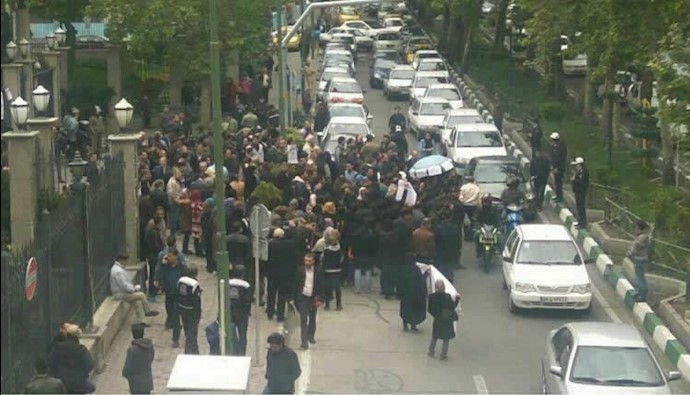
Protests by looted customers of Iranian credit institutions
What is the law of the regime itself in this regard?
According to the rules of the Iranian regime, “getting people’s money as a deposit” and then refusing to return it, in the field of law and criminal act, is considered as robbery and betrayal in trust and it will have a penalty.
But so far, the problem is that none of the institutions or banks that stole the deposit of these people have been punished or tried under the law.
According to Iran’s criminal code, what has happened to “financial institutions” regarding people’s deposited money, whether it is considered as robbery or treachery in lending or both, can be subject to legal penalties.
When did these banking institutions find legal standing?
The legalization of Iranian credit institutions was approved during the Islamic Consultative assembly in 2004 under the presidency of Mohammad Khatami.
According to Valiollah Saif, former chairman of the Central Bank of Iran, these unauthorized financial institutions were formed in the 90’s and 2000’s. On July 10, 2017, he told the IRNA news agency, “As I have repeatedly said, unlawful institutions are an issue inherited from previous governments and I and my colleagues in the Central Bank were just the heirs of this disastrous situation. In fact, the history of the development of such institutes is largely due to the decades of 90’s and 2000’s. At that time, the Ministry of Cooperatives issued credentials as credit cooperatives. The police (Nirooy-e-Entezami) also issued permits for loan funds (Sandughhay-e-Gharzolhasane)
“Unfortunately, some profitable individuals, with permissions from unrelated institutions, have taken actions that have caused disruption in recent years. These people, in the absence of being monitored by the relevant authorities and institutions, mistreated public trust and turned their limited activity into a major and quasi-bank activities, adding daily to its volume.
“And since the founders and shareholders of unauthorized institutions did not specialize in banking, they only borrowed the deposits by unusual methods using deceptive promises and offering attractive benefits. The managers of illegal institutions accumulated losses on their deposits with a promise of higher returns on deposits and lending to previous deposits from new deposits, and this resulted a large percentage of the original deposits to be lost.”
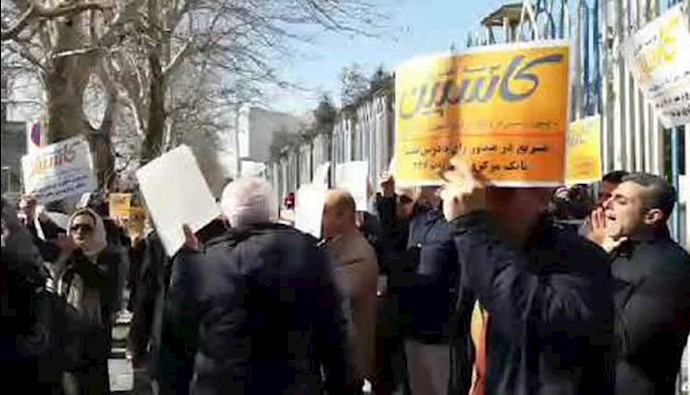
Protests by looted customers of Iranian credit institutions
The scale of financial corruption and competition of “banks” with unauthorized institutions
State-run IRNA news agency wrote on July 10, 2017: “Unauthorized financial institutions have been trying to attract the bank customers with any kind of tricks, including promises of big profits and so on. On the other hand, in a vulgar market reaction, major banks were also found to be in a disproportionate competition to keep thousands of billions of rials of liquidities out of their resources.”
But those who lost their investments in this trap are not the big banks, but the depositors, or in other words the “looted” who deposited all their savings in these banks and financial institutions.
According to Hossein Ali Haji Daligani, MP:
“People are worried because about 20 million of the population of this country are involved in various institutions such as Caspian, Fereshtegan, Arman, Samen and others. The current condition of these credit institutions causes them to be unable to refund people’s deposits. Their answer is that since they’ve deposited their money right after 2017, whatever they have earned or deposited is considered as the initial deposit, or in other words the capital market is at stake.” (Government news agency Tasnim, July 11, 2019)
“Iran” newspaper wrote about such financial institutions:
“According to information provided by the Central Bank over the years in which the Central Bank has been the subject of oversight of financial and credit institutions, nearly 6,000 institutions have been established with the permission of other organizations. During this period, police(Niruy-e-Entezami) have issued licenses for 5,000 mortgage funds, also the Ministry of Cooperatives has issued licenses to 1000 cooperatives.”
Based on the report of this government newspaper, some of these unauthorized institutions, which according to the law were obliged to obtain a license from Central Bank, had thousands of branches across the country, attracting millions of depositors, and taking hold of part of the country’s liquidity.
According to “Iran” newspaper: “One of the most famous and largest unauthorized financial and credit institutions was ‘Mizan,’ which was established with the congregation of some judiciary retirees!”
There are two responsible groups in the current state of banks and the financial and economic crisis in the country:
In an article in July 17, 2017, the government website “Tasnim,” affiliated to the terrorist Quds Force of the Revolutionary Guards, quoted Abdul Hussein Khosrowpanah, a cleric teaching at the seminary:
“Today, these banks are confronting the country and paralyzing the economy. There are two groups who are responsible in the current situation of banks and the financial and economic crisis in the country, and should be held accountable:
“First, some jurists who regularly pass religious justifications for loans and bank profits and judge on the validity (legality) of these activities by using jurisprudential titles, and sometimes disguise themselves behind religious reasonings to justify themselves and close their eyes to the negative effects of banking activities.
“The second group is some of the country’s economists who gain their own profit from their private organizations and companies by providing large amounts of loans and profits which bring them many benefits.
“I said something a year ago which some people didn’t like it and it was the fact that this ‘jurisprudence’ is in the service of the capitalist system; the meaning of that is that the jurisprudence of this group of jurists serves the capitalist system of those mentioned economists … I hope that before the banking system of the country hurts the legitimate system of the Islamic Republic, we address the problems … and save the economy of the country from collapse.”
State-run Khabar Online website also wrote in this regard: “The biggest shareholder of this illegal group is the Revolutionary Guard Corps and Basij and their own banks.”

Protests by looted customers of Iranian credit institutions
The most famous legal and illegal financial institutions in Iran
Some of the most famous institutes that can be mentioned here are:
- Institutions that were created before approving the Act of the Uncoordinated Monetary Market Regulation in 2004: These institutions have been established without official permission from government institutions and there is no statistics available about them. However, many government officials are unofficially involved in them.
- Credit institutions licensed by the Central Bank of the Islamic Republic:
- Tose’e Credit Institute
- Kowsar Credit Institute
- Melal Credit Institute
- Nour Credit Institute
- Caspian Credit Institute
- Institutions that had been integrated with each other and licensed after March 2010:
- Baran Financial and Credit Institute
- Samen alHojaj Financial and Credit Institute
- Pishgamane-Yazd Financial and Credit Institute
- Salehin Financial and Credit Institute
- Askaryeh Financial and Credit Institute
- Ferdowsi Financial and Credit Institute
- Ghavamin Financial and Credit Institute
- Karsazane-Ayandeh Financial and Credit Institute
- Mowlalmovaheddin Financial and Credit Institute
- Hafez Financial and Credit Institute
- Mizan Cooperative credit related to the regime’s judiciary retirees
- Samen Credit Institute affiliated with the Revolutionary Guards Cooperative Foundation
- Virtual organizations licensed in 2011:
- Mehr Financial and Credit institute belonging to the Basij
- Kowsar Credit Institute affiliated with Ministry of Defense
- Reyhaneh Gostar Moshiz Financial and Credit Institution
- Financial Institutions established in 2013:
- Arman Credit Institute consists of the merger of Fereshtegan, Ferdowsi, and Afzal Toos Financial and Credit Institutions.
- Samenolhojaj Credit Institute
- Melal Credit Institute, under establishment
- Kowsar Credit Institute, under establishment
- Nur Credit Institute consists of the merger of Pishgaman, Karsazane-Ayandeh and Reyhaneh Gostar Moshiz Financial and Credit Institutions.
- Financial Institutions transformed into banks:
- Sina Financial institution was renamed Sina Bank (The former Bonyad Financial & Credit institute)
- Ansar Financial and Credit Institute was renamed Ansar Bank. Former Ansarolmujahedin savings fund and loan (Gharzolhasaneh) affiliated with Revolutionary Guards
- Iranian Financial and Credit renamed to Hekmate-Iranian bank. (Affiliated to cooperative foundation of Military Forces of Islamic Republic of Iran)
- Mowlalmovaheddin Financial and Credit institute renamed to Iran Zamin Bank
- Ghawamin Financial and Credit institute renamed to Ghawamin Bank. (Affiliated with state security police forces). Etemade-Iranian Financial and Credit Institute wasn’t approved by Central Bank so merged to Ghawamin Bank
- Ayandhara Bank was the merger of Salehin and Ative Financial and Credit Institutes
- Mehr Financial and Credit Institute renamed to Mehr Eghtesad Bank (Under establishment) (Affiliated to the Basij)
The widespread crisis of the plundered
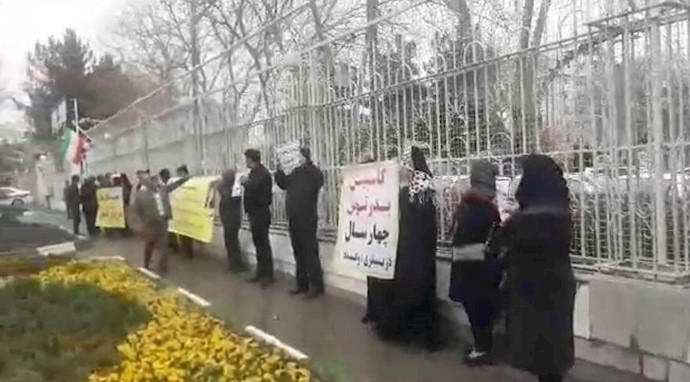
Protests by looted customers of Iranian credit institutions
Such institutions have been a problem in the society since the early 2010’s, causing some media networks to refer to aspects of the issue of plundered people.
The crisis, which emerged during the presidency of Hassan Rouhani and Valiollah Saif as the Central Bank chairman, began when after 2013, they increased the interest on deposits so that they could recoup their monthly liquidity deficit by attracting new investors. At the same time, the judiciary and the Central Bank announced the possibility of a deficit of their assets in the media, which resulted in the onslaught of the “plundered” people to get back their money. This caused a shortage of liquidity and bankruptcy of institutions, and depositors even often failed to get their initial deposits back.
The negative effects of the failure to refund public deposits by these institutions affected the lives of millions of Iranians directly and indirectly. The looted people first attempted to withdraw their deposits by trying legal ways, but after their fruitless pursuits, despite the tyranny and repression dominated by the ruling organs of society, they formed scattered crowds behind the doors of the same institutions. They found one another united with the same common pain and held constant daily gatherings that became known as the looted rally.
These constant gatherings began to turn to small regular protest rallies and they gradually became demonstrations and rallies against government officials and heads of regime institutions.
Rallies by bankrupt depositors lead to massive protests
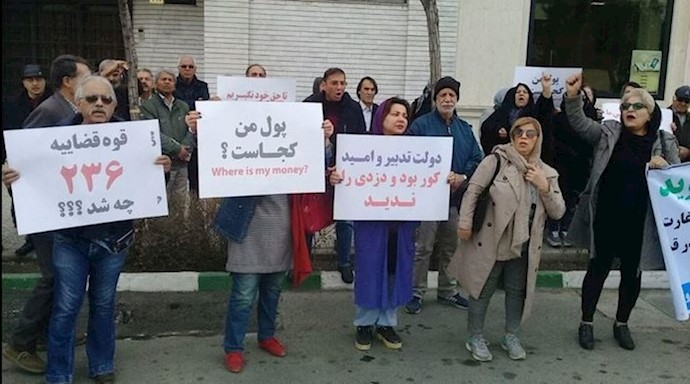
Protests by looted customers of Iranian credit institutions
Perhaps the first protests of depositors of Iranian credit institutions dates back to 2016-2017. The small demonstrations merged and quickly turned into a formidable community of Iranians who were able to hold rallies for the same subject. A demonstration was held in several places simultaneously in Tehran and other cities, and it became renowned as the protest of the looted.
Small movements of these people could be called a turning point in the history of Iran’s popular protests in the atmosphere of repression of the ruling tyranny in Iran. After the protests of the looted depositors spread throughout Iran, other classes of the Iranian community also realized that they could make protest rallies for their demands. Given the role of regime officials and institutions in creating this situation, many of these protest rallies gradually became political demonstrations against government corruption.
The protests formed in the face of economic and trade-related problems are the tip of the iceberg, most of which are the political dissatisfaction and desire of Iranians to overthrow the dictatorial regime. The people of Iran, who have been oppressed and suppressed for 40 years, and deprived of their basic rights and freedoms, present themselves in the organized movements of economic and trade problems as an excuse to begin their protests. Meanwhile, the general uprising of January 2018 was apparently due to an increase in the price of eggs, but the unrest spread in more than 140 cities and the slogans quickly changed against the Iranian regime, and people called for the overthrow of the dictatorship.
The protest of the looted people continues in the context of Iran’s nationwide uprisings of 2018, and in conjunction with the protest movements of other segments of the Iranian society. It is a new factor that has further driven a rift between the Iranian regime and its public and non-public affiliated organs on the one hand and the people of Iran on the other. And this is what has provoked fear in the Iranian government.





